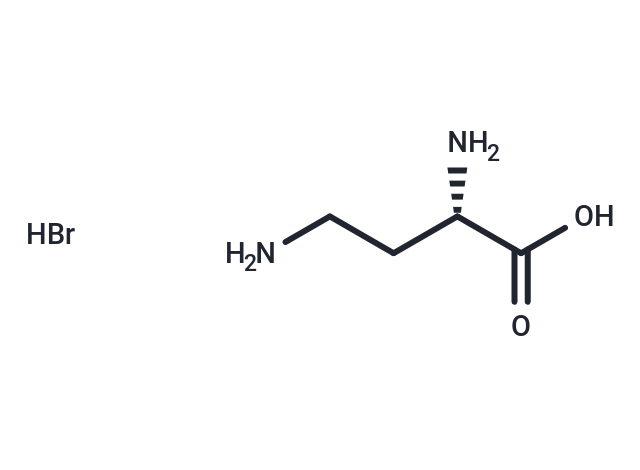Shopping Cart
Remove All Your shopping cart is currently empty
Your shopping cart is currently empty
L-DABA hydrobromide (L-2,4-Diaminobutyric acid hydrobromide) is a potent GABA transaminase inhibitor with antitumor and anticonvulsant activity for the study of neurological disorders.

| Pack Size | Price | USA Warehouse | Global Warehouse | Quantity |
|---|---|---|---|---|
| 100 mg | $41 | In Stock | In Stock |
| Description | L-DABA hydrobromide (L-2,4-Diaminobutyric acid hydrobromide) is a potent GABA transaminase inhibitor with antitumor and anticonvulsant activity for the study of neurological disorders. |
| In vitro | Incubation with 10 mM L-2,4-Diaminobutyric acid for 24 h at 37°C irreversibly and completely damages tumor cells. The cell-destructive effect caused by L-DABA hydrobromide is likely a result of osmotic lysis induced by the non-saturated intracellular accumulation of L-DABA hydrobromide. Concomitant incubation with L-alanine and L-methionine can abolish the harmful effect of L-DABA hydrobromide[1]. Kinetic studies indicate that L-DABA hydrobromide is a non-linear, non-competitive inhibitor of GABA transaminase activity. The elevation of GABA levels induced by L-DABA hydrobromide parallels the inhibition of GABA transaminase activity[2]. L-2,4-Diaminobutyric acid, an amino acid analogue, produces a cytolytic effect with a human glioma cell line, SKMG-1, and normal human fibroblasts. The concentrations of L-DABA hydrobromide necessary to reduce the cell count to 50% of control following a 24-h incubation at 37°C are 12.5 mM for the human fibroblasts and 20 mM for the glioma cell line[2]. |
| In vivo | Treatment with L-DABA hydrobromide leads to a 43.4% reduction in tumor growth[1]. In vivo, L-DABA hydrobromide more effectively inhibits GABA transaminase than it does in vitro[3]. |
| Synonyms | L-2,4-Diaminobutyric acid hydrobromide |
| Molecular Weight | 199.05 |
| Formula | C4H11BrN2O2 |
| Cas No. | 73143-97-2 |
| Smiles | Br.NCC[C@H](N)C(O)=O |
| Sequence | H-Dab-OH |
| Sequence Short | X |
| Storage | keep away from moisture | Powder: -20°C for 3 years | In solvent: -80°C for 1 year | Shipping with blue ice/Shipping at ambient temperature. | ||||||||||||||||||||
| Solubility Information | DMSO: 2 mg/mL (10.05 mM), Sonication is recommended. | ||||||||||||||||||||
Solution Preparation Table | |||||||||||||||||||||
DMSO
| |||||||||||||||||||||
| Size | Quantity | Unit Price | Amount | Operation |
|---|

Copyright © 2015-2026 TargetMol Chemicals Inc. All Rights Reserved.